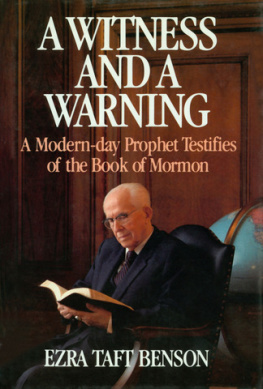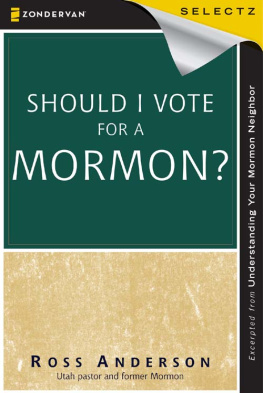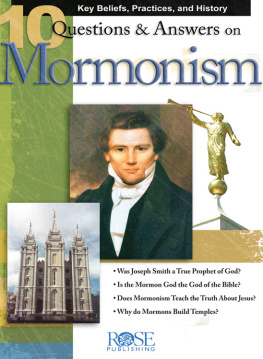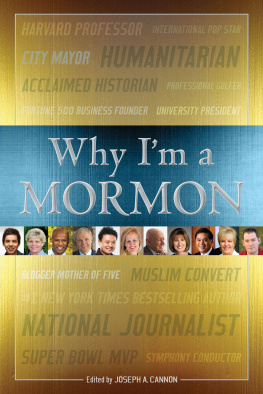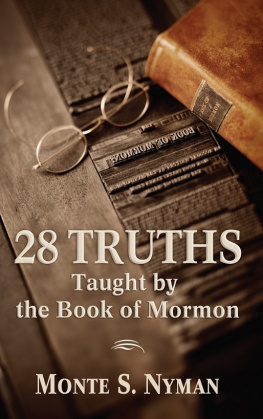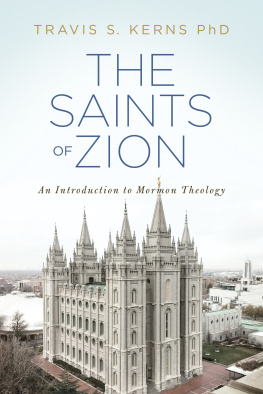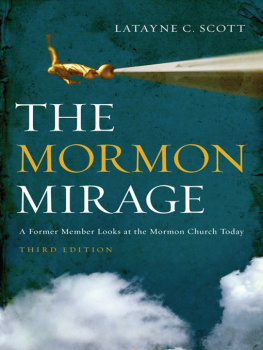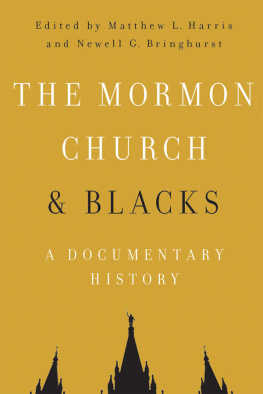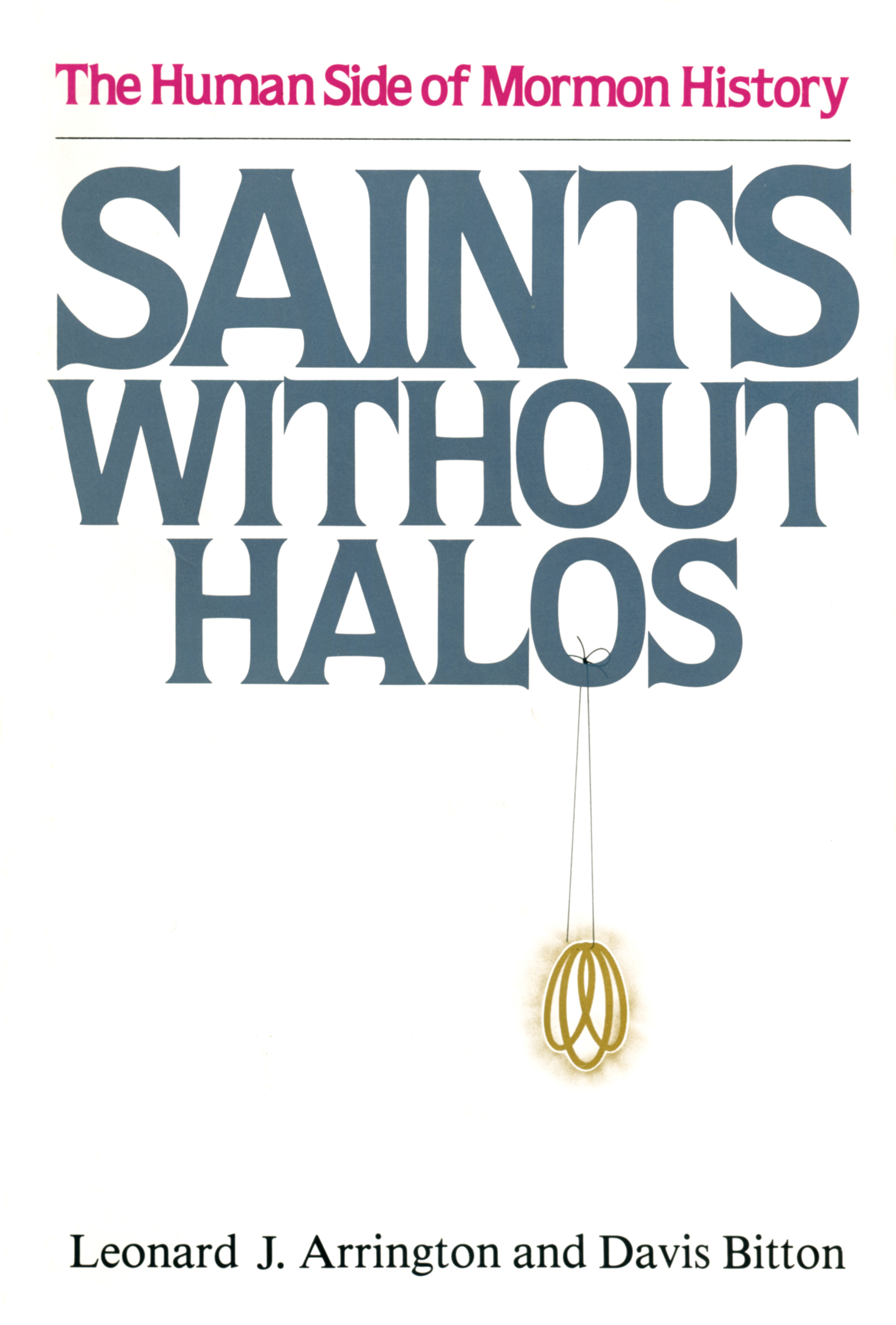Saints Without Halos:
The Human Side of Mormon History
Leonard J. Arrington and Davis Bitton
Signature Books Salt Lake City
on the cover :
Unlike most Mormon histories, Saints without Halos is a treatment of the human, rather than institutional side of Mormon history. Through the fascinating experiences of seventeen Latter-day Saints, Leonard J. Arrington and Davis Bitton sketch Mormonism from its earliest beginnings to modern times. These are Saints presented not as objects of veneration, but as human beings who, like the rest of us, struggle to be worthy of the title Latter-day Saint.
Two were apostles. One was an enthusiastic supporter and friend of Joseph Smith, who eventually left the main body of the Church to lead his own band to Texas. The other was a link in the chain of a renowned Mormon family whose positions in the leading councils of the Church span virtually the entire history of Mormonism.
The other fifteen individuals, except for one colorful non-Mormon advocate, are ordinary Latter-day Saintsfaithful members who helped realize the vision of their prophetic leaders: a personal friend of Joseph Smith, missionaries and converts, a plural wife, an Indian woman, a widowed immigrant, pioneers and philosophers, bishops and blacksmiths, and even a historian.
In this book, the authors of The Mormon Experience draw on their vast knowledge of Mormon diaries and other first-hand accounts to disclose the rich diversity of Mormonism as well as its unity of purpose.
about the authors:
Leonard J. Arrington is Director of the Joseph Fielding Smith Institute for Church History and the Lemuel H. Redd Professor of Western History at Brigham Young University. Born in Twin Falls, Idaho, in 1917, Dr. Arrington received his degrees from the Universities of Idaho and North Carolina. He is the author of several books on Mormon history, including the classic Great Basin Kingdom (1958). He is a regular contributor to many scholarly journals and has taught at North Carolina State, UCLA, and Utah State University.
Davis Bitton is Professor of History at the University of Utah and compiler of A Guide to Mormon Diaries and Autobiographies (1977), as well as several other books and numerous articles on Mormon history. Born in Blackfoot, Idaho, in 1930, Dr. Bitton received his degrees from Brigham Young and Princeton Universities and has taught at the University of Texas and the University of California at Santa Barbara.
Arrington and Bitton are co-authors of the widely acclaimed book, The Mormon Experience (1979). For many years they served as Church Historian and Assistant Church Historian for The Church of Jesus Christ of Latter-day Saints.
Copyright 1981 by Signature Books
Salt Lake City, Utah
All Rights Reserved
ISBN 0-941214-01-X (Hardback)
Printed in the United States of America
Contents
14. Ephraim and Edna Ericksen:
The Philosopher and the Trail Builder
Introduction
H istory is often portrayed as the story of movements and their leaders. Typically, historians emphasize key figures who change the course of history by their charismatic personalities, genius, creativityor simple good fortune. In Latter-day Saint history there has been a tendency to ignore what happens below the top level of administration. The lives of those who drive the engines of history are ignored, often because they leave no written records, but just as often because they are not considered important. Such an attitude is unfortunate, for the vitality and strength of any movement is expressed in the diversity of its experience as well as its unity of purpose.
Mormon history abounds with people of all shapes, sizes, nationalities, and personalities. Their individual stories are not well enough known. Quite apart from the notable lives of the General Authorities there is a wealth of experience in the stories of the membersmen and women who, as teachers, bishops, stake presidents, and Relief Society presidents, served faithfully in the vineyards to which they were called.
Historians have a vast reservoir of personal records to tap as they present the human side of Mormon history, as well as the institutional side. When one of the authors compiled Guide to Mormon Diaries and Autobiographies , he found nearly three thousand first-hand accounts in public repositories; at least that many more remain virtually unknown in the possession of family members. In this decade alone, thousands of personal histories have been written in response to the counsel of President Spencer W. Kimball. Though many of these will interest only the family of the person keeping the record, many others will certainly interest future historians as they describe the recent expansion of the Church and explore what it means to be a Latter-day Saint in Japan, in Mexico, in Africain all parts of the world.
Of the many stories which could be told, we have selected these for their intrinsic value and because they illuminate various facets of our history: early conversion and sacrifice, proselyting, gathering, colonizing, building the kingdom in distant lands, and transforming and modernizing Church programs.
For the most part, these are mainstream Mormons, Latter-day Saints whose lives reflect the beliefs and values of traditional Mormonism. Only two were General Authorities. All were committed to the restored gospel, although some understood it differently than others. All had their burdens to bear, which they did in their own ways and with varying degrees of success. They are not objects of veneration but human beings who, like the rest of us, struggle to be worthy of the title Latter-day Saint. They are Saints without halos.
Portions of some chapters have appeared in different form in Arizona and the West , BYU Studies , the Church News , the Las Vegas Sun , and the New Era . We have benefited from the research and editorial work of Scott Kenney and express our appreciation for his help.
PART ONE: From the Beginnings to the Great Basin
T he first period of Mormon history was not long, but it was exceptionally varied and restless. The main lines are well known: Joseph Smiths youthful quest for religious certainty and the spiritual manifestations that followed; the coming forth of the Book of Mormon; the organization of the Church in upstate New York; the move to Kirtland, Ohio; the gathering to Missouri; the persecution in both places; the establishment of a new headquarters in Nauvoo, Illinois; the martyrdom of the Prophet; the expulsion from Nauvoo and the trek across the plains to refuge in the Great Basin. Such is the main story line of the Churchs first decades.
But there were many subcurrents and side eddies. The missionary net was flung wide and each convert gathered in had his or her own story to tell. Joseph Knight, one of the first to hear the restoration message, came to Joseph Smiths aid when he needed help to continue translating the Book of Mormon, participated in events leading up to the organization of the Church, and became a stalwart in the first branch.
Jonathan Hale, a good example of the first missionaries who spread the gospel message, also played an important role in the move of the Kirtland Camp to Missouri; he later assisted the poor to relocate in Illinois and eventually helped supervise the evacuation of Nauvoo.
Lyman Wight, second in command of Zions Camp, member of the stake presidency in Missouri, fellow-prisoner with the Prophet in Liberty Jail, and finally, apostle, left the main body of the Church and led his own band of followers to Texas. His experience reminds us that people were moving out of the Church as well as coming in. Nine apostles in Joseph Smiths first Quorum of the Twelve were excommunicated, and thousands of others have left the Church for their own reasons, many after having made significant, enduring contributions to the advancement of the gospel.


